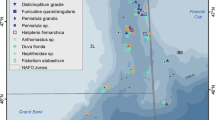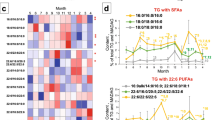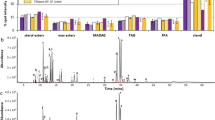Abstract
Fatty acid (FA) markers are widely used for tracking trophic relationships in cold-water benthic ecosystems, but data on the lipid composition of soft corals and hydrocorals, which are important components of these ecosystems, are very limited. Lipid class and FA profiles of four soft coral families (eleven species) and one hydrocoral family (four species) from the northeastern part of the Sea of Okhotsk were studied for the first time and compared with their tropical counterparts. Among cold-water cnidarians, soft corals contained much more monoalkyldiacylglycerols but less triacylglycerols than hydrocorals. The lipid class profile of all azooxanthellate soft corals did not differ, whereas FA profiles of these corals from cold-water and tropical regions differed. The key FAs were arachidonic (20:4n-6) and eicosapentaenoic (20:5n-3) acids, followed by 24:5n-6 and 24:6n-3. Within the cold-water corals, a sharp difference in polyunsaturated FA (PUFA) profiles between Primnoidae species and other families (Nephtheidae, Paragorgiidae, and Acanthogorgiidae) was found. The high level of n-3 PUFAs (20:5n-3 and 24:6n-3) in Primnoidae and the high level of n-6 PUFAs (20:4n-6 and 24:5n-6) in other cold-water coral families indicated the substantial difference in a feeding behavior between these corals inhabiting the same biotope. Based on the FA markers, a dietary predomination of herbivorous zooplankton is assumed for Primnoidae. An opportunistic feeding on various food sources is supposed for other cold-water coral families studied. The lipid and FA profiles were found to be characteristic for tropical zooxanthellate reef-building and soft corals, azooxanthellate soft corals from tropical and cold-water regions, and Primnoidae among cold-water coral families.






Similar content being viewed by others
References
Andersson BA (1978) Mass spectrometry of fatty acid pyrrolidides. Prog Chem Fats Other Lipids 16:279–308
Anthony KRN (1999) Coral suspension feeding on fine particulate matter. J Exp Mar Biol Ecol 232:85–106
Anthony KRN (2000) Enhanced particle-feeding capacity of corals on turbid reefs (Great Barrier Reef, Australia). Coral Reefs 19:59–67
Auel H, Harjes M, Da Rocha R, Stübing D, Hagen W (2002) Lipid biomarkers indicate different ecological niches and trophic relationships of the Arctic hyperiid amphipods Themisto abyssorum and T. libellula. Polar Biol 25:374–383
Bishop DG, Kenrick JR (1980) Fatty acid composition of symbiotic zooxanthellae in relation to their hosts. Lipids 15:799–804
Cairns SD, Bayer FM (2009) A generic revision and phylogenetic analysis of the Primnoidae (Cnidaria: Octocorallia). SMC Zool 629:1–79
Carreau JP, Dubacq JP (1978) Adaptation of macro-scale method to the micro-scale for fatty acid methyl transesterification of biological lipid extracts. J Chromatogr 151:384–390
Chen W-NU, Kang H-J, Weis VM, Mayfield AB, Jiang P-L, Fang L-S, Chen C-S (2012) Diel rhythmicity of lipid-body formation in a coral-Symbiodinium endosymbiosis. Coral Reefs 31:521–534
Christie WW (1988) Equivalent chain-lengths of methyl ester derivatives of fatty acids on gas chromatography—a reappraisal. J Chromatogr 447:305–314
Dalsgaard J, St John MS, Kattner G, Müller-Navarra D, Hagen W (2003) Fatty acid trophic markers in the pelagic marine environment. Adv Mar Biol 46:225–340
Davies AJ, Duineveld GCA, Lavaleye MSS, Bergman MJN, van Haren H, Roberts MJ (2009) Downwelling and deep-water bottom currents as food supply mechanisms to the cold-water coral Lophelia pertusa (Scleractinia) at the Mingulay Reef complex. Limnol Oceanogr 54:620–629
Dodds LA, Black KD, Orr H, Roberts JM (2009) Lipid biomarkers reveal geographical differences in food supply to the cold-water coral Lophelia pertusa (Scleractinia). Mar Ecol Prog Ser 397:113–124
Duineveld GCA, Lavaleye MSS, Berghuis EM (2004) Particle flux and food supply to a seamount cold-water coral community (Galicia Bank, NW Spain). Mar Ecol Prog Ser 277:13–23
Duineveld GCA, Lavaleye MSS, Bergman MJN, De Stigter H, Mienis F (2007) Trophic structure of a cold-water coral mound community (Rockall Bank, NE Atlantic) in relation to the near-bottom particle supply and current regime. Bull Mar Sci 81:449–467
Duineveld GCA, Jeffreys RM, Lavaleye MSS, Davies AJ, Bergman MJN, Watmough T, Witbaard R (2012) Spatial and tidal variation in food supply to shallow cold-water coral reefs of the Mingulay Reef complex (Outer Hebrides, Scotland). Mar Ecol Prog Ser 444:97–115
Fabricius KE, Dommisse M (2000) Depletion of suspended particulate matter over coastal reef communities dominated by zooxanthellate soft corals. Mar Ecol Prog Ser 196:157–167
Fabricius KE, Benayahu Y, Genin A (1995) Herbivory in asymbiotic soft corals. Science 268:90–92
Falk-Petersen S, Hagen W, Kattner G, Clarke A, Sargent J (2000) Lipids, trophic relationships, and biodiversity in Arctic and Antarctic krill. Can J Fish Aquat Sci 57(Suppl. 3):178–191
Hamoutene D, Puestow T, Miller-Banoub J, Wareham V (2008) Main lipid classes in some species of deep-sea corals in the Newfoundland and Labrador region (Northwest Atlantic Ocean). Coral Reefs 27:237–246
Harland AD, Navarro JC, Spencer Davies P, Fixter LM (1993) Lipids of some Caribbean and Red Sea corals: total lipid, was esters, triglycerides and fatty acids. Mar Biol 117:113–117
Imbs AB (2013) Fatty acids and other lipids of corals: composition, distribution, and biosynthesis. Russ J Mar Biol 39:153–168
Imbs AB (2016) High level of tetracosapolyenoic fatty acids in the cold-water mollusk Tochuina tetraquetra is a result of the nudibranch feeding on soft corals. Polar Biol. doi:10.1007/s00300-015-1865-y
Imbs AB, Latyshev NA (2012) Fatty acid composition as an indicator of possible sources of nutrition for soft corals of the genus Sinularia (Alcyoniidae). J Mar Biol Ass UK 92:1341–1347
Imbs AB, Yakovleva IM (2012) Dynamics of lipid and fatty acid composition of shallow-water corals under thermal stress: an experimental approach. Coral Reefs 31:41–53
Imbs AB, Demina OA, Demidkova DA (2006) Lipid class and fatty acid composition of the boreal soft coral Gersemia rubiformis. Lipids 41:721–725
Imbs AB, Luu HV, Pham LQ (2007) Intra- and interspecific variability of fatty acid composition of soft corals. Russ J Mar Biol 33:67–70
Imbs AB, Demidkova DA, Dautova TN, Latyshev NA (2009) Fatty acid biomarkers of symbionts and unusual inhibition of tetracosapolyenoic acid biosynthesis in corals (Octocorallia). Lipids 44:325–335
Imbs AB, Latyshev NA, Dautova TN, Latypov YY (2010) Distribution of lipids and fatty acids in corals by their taxonomic position and presence of zooxanthellae. Mar Ecol Prog Ser 409:65–75
Imbs AB, Yakovleva IM, Dautova TN, Bui LH, Jones P (2014) Diversity of fatty acid composition of symbiotic dinoflagellates in corals: evidence for the transfer of host PUFAs to the symbionts. Phytochemistry 101:76–82
Iverson SJ (2008) Tracing aquatic food webs using fatty acids: from qualitative indicators to quantitative determination. In: Arts MT, Brett MT, Kainz M (eds) Lipids in aquatic ecosystems. Springer, New York, pp 281–307
Joseph JD (1979) Lipid composition of marine and estuarine invertebrates: porifera and Cnidaria. Prog Lipid Res 18:1–30
Kattner G, Hagen W (1995) Polar herbivorous copepods—different pathways in lipid biosynthesis. ICES J Mar Sci 52:329–335
Kelly JR, Scheibling RE (2012) Fatty acids as dietary tracers in benthic food webs. Mar Ecol Prog Ser 446:1–22
Kharlamenko VI, Brandt A, Kiyashko SI, Würzberg L (2013) Trophic relationship of benthic invertebrate fauna from the continental slope of the Sea of Japan. Deep-Sea Res Pt II 86–87:34–42
Kiriakoulakis K, Fisher L, Freiwald A, Grehan A, Roberts JM, Wolff GA (2005) Lipids and nitrogen isotopes of two deepwater corals from the North-East Atlantic: initial results and implications for their trophic regime. In: Freiwald A, Roberts JM (eds) Cold-water corals and ecosystems. Springer, Berlin, pp 715–729
Latyshev NA, Naumenko NV, Svetashev VI, Latypov YY (1991) Fatty acids of reef building corals. Mar Ecol Prog Ser 76:295–301
Legeżyńska J J, Kędra M, Walkusz W (2014) Identifying trophic relationships within the high Arctic benthic community: how much can fatty acids tell? Mar Biol 161:821–836
Mancini I, Guerriero A, Guella G, Bakken T, Zibrowius H, Pietra F (1999) Novel 10-hydroxydocosapolyenoic acids from deep-water scleractinian corals. Helv Chim Acta 82:677–684
Mansour MP, Volkman JK, Jackson AE, Blackburn SI (1999) The fatty acid and sterol composition of five marine dinoflagellates. J Phycol 35:710–720
Monroig Ó, Tocher DR, Navarro JC (2013) Biosynthesis of polyunsaturated fatty acids in marine invertebrates: recent advances in molecular mechanisms. Mar Drugs 11:3998–4018
Mueller CE, Larsson AI, Veuger B, Middelburg JJ, van Oevelen D (2014) Opportunistic feeding on various organic food sources by the cold-water coral Lophelia pertusa. Biogeosciences 11:123–133
Oku H, Yamashiro H, Onaga K, Sakai K, Iwasaki H (2003) Seasonal changes in the content and composition of lipids in the coral Goniastrea aspera. Coral Reefs 22:83–85
Parrish CC, Thompson RJ, Deibel D (2005) Lipid classes and fatty acids in plankton and settling matter during the spring bloom in a cold ocean coastal environment. Mar Ecol Prog Ser 286:57–68
Patton JS, Battey JF, Rigler MW, Porter JW, Black CC, Burris JE (1983) A comparison of the metabolism of bicarbonate 14C and acetate 1-14C and the variability of species lipid compositions in reef corals. Mar Biol 75:121–130
Reuss N, Poulsen LK (2002) Evaluation of fatty acids as biomarkers for a natural plankton community. A field study of a spring bloom and a post-bloom period off West Greenland. Mar Biol 141:423–434
Rodrigues LJ, Grottoli AG, Pease TK (2008) Lipid class composition of bleached and recovering Porites compressa Dana, 1846 and Montipora capitata Dana, 1846 corals from Hawaii. J Exp Mar Biol Ecol 358:136–143
Sargent JR, Henderson RJ (1986) Lipids. In: Corner EDS, O’Hara SCM (eds) The biological chemistry of marine copepods. Clarendon Press, Oxford, pp 59–108
Sargent JR, Parkes RJ, Mueller-Harvey I, Henderson RJ (1987) Lipid biomarkers in marine ecology. In: Sleigh MA (ed) Microbes in the sea. Ellis Horwood, Chicester, pp 119–138
Saunders SM, Radford B, Bourke SA, Thiele Z, Bech T, Mardon J (2005) A rapid method for determining lipid fraction ratios of hard corals under varying sediment and light regimes. Environ Chem 2:331–336
Seemann J, Sawall Y, Auel H, Richter C (2013) The use of lipids and fatty acids to measure the trophic plasticity of the coral Stylophora subseriata. Lipids 48:275–286
Sherwood OA, Jamieson RE, Edinger EN, Wareham VE (2008) Stable C and N isotopic composition of cold-water corals from the Newfoundland and Labrador continental slope: examination of trophic, depth and spatial effects. Deep-Sea Res Part I 55:1392–1402
Slattery M, McClintock JB, Bowser SS (1997) Deposit feeding: a novel mode of nutrition in the Antarctic colonial soft coral Gersemia antarctica. Mar Ecol Prog Ser 149:299–304
Sorokin YI (1993) Coral reef ecology. Springer, Heidelberg
Spiro B, Roberts M, Gage J, Chenery S (2000) 18O/16O and 13C/12C in an ahermatypic deepwater coral Lophelia pertusa from the North Atlantic, a case of disequilibrium isotope fractionation. Rapid Commun Mass Sp 14:1332–1336
Sprecher H (2000) Metabolism of highly unsaturated n-3 and n-6 fatty acids. Biochim Biophys Acta 1486:219–231
Stimson JS (1987) Location, quantity and rate of change in quantity of lipids in tissue of Hawaiian hermatypic corals. Bull Mar Sci 41:889–904
Suhr SB, Pond DW, Gooday AJ, Smith CR (2003) Selective feeding by benthic foraminifera on phytodetritus on the western Antarctic Peninsula shelf: evidence from fatty acid biomarker analysis. Mar Ecol Prog Ser 262:153–162
Svetashev VI, Vysotskii MV (1998) Fatty acids of Heliopora coerulea and chemotaxonomic significance of tetracosapolyenoic acids in coelenterates. Comp Biochem Physiol 119B:73–75
Teece MA, Estes B, Gelsleichter E, Lirman D (2011) Heterotrophic and autotrophic assimilation of fatty acids by two scleractinian corals, Montastraea faveolata and Porites astreoides. Limnol Oceanogr 56:1285–1296
Treignier C, Grover R, Ferrier-Pages C, Tolosa I (2008) Effect of light and feeding on the fatty acid and sterol composition of zooxanthellae and host tissue isolated from the scleractinian coral Turbinaria reniformis. Limnol Oceanogr 53:2702–2710
Treignier C, Tolosa I, Grover R, Reynaud S, Ferrier-Pagés C (2009) Carbon isotope composition of fatty acids and sterols in the scleractinian coral Turbinaria reniformis: effect of light and feeding. Limnol Oceanog 54:1933–1940
Venn AA, Loram JE, Douglas AE (2008) Photosynthetic symbioses in animals. J Exp Bot 59:1069–1080
Volkman JK, Jeffrey SW, Nichols PD, Rogers GI, Garland CD (1989) Fatty acids and lipid composition of 10 species of microalgae used in mariculture. J Exp Mar Biol Ecol 128:219–240
Vysotskii MV, Svetashev VI (1991) Identification, isolation and characterization of tetracosapolyenoic acids in lipids of marine coelenterates. Biochim Biophys Acta 1083:161–165
Yamashiro H, Oku H, Higa H, Chinen I, Sakai K (1999) Composition of lipids, fatty acids and sterols in Okinawan corals. Comp Biochem Physiol 122B:397–407
Yamashiro H, Oku H, Onaga K (2005) Effect of bleaching on lipid content and composition of Okinawan corals. Fish Sci 71:448–453
Zar JH (1999) Biostatistical analysis, 4th edn. Prentice-Hall, New York
Acknowledgments
We are grateful to Dr. N.I. Selin for the collection of specimens. We thank Dr. V.I. Kharlamenko for the help in PRIMER 6 statistical analyses and reviewing drafts of this paper. This work was supported by grants 09-04-98542 and 15-04-02686 from the Russian Foundation for Basic Research and grant VANT16-003 from the Russian Academy of Sciences.
Funding
This study was funded by grants 09-04-98542 and 15-04-02686 from the Russian Foundation for Basic Research.
Author information
Authors and Affiliations
Corresponding author
Ethics declarations
Conflict of interest
All authors declare that they have no conflict of interest.
Ethical approval
This article does not contain any studies with human participants or vertebrate animals performed by any of the authors. All the experiments on invertebrate animals (Cnidarians) were reviewed and approved by the Ethics Committee of A.V. Zhirmunsky Institute of Marine Biology of the Far-Eastern Branch of the Russian Academy of Sciences.
Additional information
Responsible Editor: L. D. Mydlarz.
Reviewed by L. Santiago-Vazquez and L. D. Mydlarz.
Electronic supplementary material
Below is the link to the electronic supplementary material.
Rights and permissions
About this article
Cite this article
Imbs, A.B., Demidkova, D.A. & Dautova, T.N. Lipids and fatty acids of cold-water soft corals and hydrocorals: a comparison with tropical species and implications for coral nutrition. Mar Biol 163, 202 (2016). https://doi.org/10.1007/s00227-016-2974-z
Received:
Accepted:
Published:
DOI: https://doi.org/10.1007/s00227-016-2974-z




